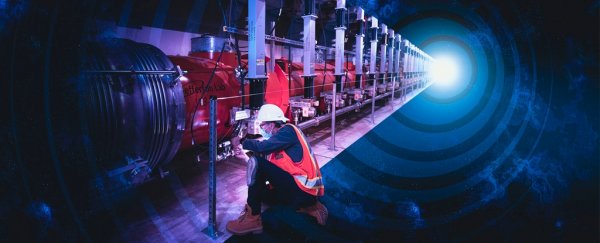A particle accelerator that slams electrons together here on Earth has achieved temperatures colder than those of outer space.
Using the X-ray free-electron laser at the Department of Energy's SLAC National Accelerator Laboratory – part of an upgrade project to the Linac Coherent Light Source (LCLS), called LCLS II – scientists chilled liquid helium to minus 456 degrees Fahrenheit (minus 271 degrees Celsius), or 2 kelvins.
That is just 2 kelvins above absolute zero, the coldest possible temperature at which all particle movement ceases.
That frosty environment is crucial for the accelerator, because at such low temperatures the machine becomes superconducting, meaning it can boost electrons through it with just about zero energy loss.
Even empty regions of space aren't this cold, as they are still filled with the cosmic microwave background radiation, a remnant from shortly after the Big Bang that has a uniform temperature of minus 454 F (minus 271 C), or 3 K.
"The next-generation superconducting accelerator of the LCLS-II X-ray free-electron laser has reached its operating temperature of 2 degrees above absolute zero," Andrew Burrill, director of the SLAC's Accelerator Directorate, told Live Science.
LCLS-II is now ready to begin accelerating electrons at 1 million pulses per second, which is a world record, he added.
"This is four orders of magnitude more pulses per second than its predecessor, LCLS, meaning that – in just a few hours – we will have sent more X-rays to users [who aim to utilize them in experiments] than LCLS has done in the past 10 years," Burrill said.
This is one of the last milestones that LCLS-II needs to achieve before it can go on to produce X-ray pulses that are on average 10,000 times brighter than those created by its predecessor.
This should help researchers to probe complex materials in unprecedented detail. The high-intensity, high-frequency laser pulses enable researchers to see how electrons and atoms in materials interact with unprecedented clarity.
This will have a number of applications, from helping to reveal "how natural and man-made molecular systems convert sunlight into fuels, and thus how to control these processes, to understanding the fundamental properties of materials that will enable quantum computing," Burill said.
Related: 10 cosmic mysteries the Large Hadron Collider could unravel
Creating the freezing climes inside the accelerator took some work. To keep the helium from boiling away, for instance, the team needed super-low pressures.
Eric Fauve, director of the Cryogenic Division at SLAC, told Live Science that at sea level, pure water boils at 212 F (100 C), but this boiling temperature varies with pressure.
For example, in a pressure cooker, the pressure is higher, and water boils at 250 F (121 C), while the reverse is true at altitude, where pressure is lower and water boils at a lower temperature.
"For helium, it is very much the same. At atmospheric pressure, helium will boil at 4.2 kelvin, however; this temperature will decrease if the pressure decreases," Fauve said.
"To lower the temperature to 2.0 kelvin, we need to have a pressure of just 1/30 of atmospheric pressure."
To achieve these low pressures, the team uses five cryogenic centrifugal compressors, which compress the helium to cool it and then let it expand in a chamber to lower the pressure, making it one of the few places on Earth where 2.0 K helium can be produced on a large scale.
Fauve explained that each cold compressor is a centrifugal machine equipped with a rotor/impeller similar to the one of an engine turbo-compressor.
"While spinning, the impeller accelerates the helium molecules creating a vacuum at the center of the wheel where molecules are sucked, generating pressure at the periphery of the wheel where molecules [are] ejected," he said.
Compression forces the helium to take its liquid state, but the helium escapes into this vacuum, where it expands rapidly, cooling as it does so.
In addition to its ultimate applications, the ultra-cold hydrogen created at LCLS-II is a scientific curiosity in itself.
"At 2.0 kelvin helium becomes a superfluid, called helium II, that has extraordinary properties," Fauve said. For instance, it conducts heat hundreds of times more efficiently than copper, and it has such low viscosity – or resistance to flow – that this can't be measured, he added.
For LCLS-II, 2 kelvins is as low as temperatures are expected to go.
"Lower temperatures can be achieved with very specialized cooling systems that can reach a fraction of a degree above absolute zero, where all motion stops," Burrill said.
But this particular laser doesn't have the ability to reach those extremes, he said.
Related content:
Scientists just broke the record for the coldest temperature ever recorded in a lab
7 ways Einstein changed the world
The 15 weirdest galaxies in our universe
This article was originally published by Live Science. Read the original article here.
